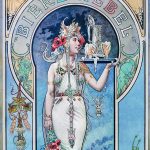Giambologna, born as Jean Boulogne on 1529 in Douai, Flanders (now part of France), and later known as Giovanni da Bologna or Giambologna, was a renowned sculptor of the late Renaissance. His innovative works and mastery of the human form left an indelible mark on the art world of his time and continue to influence generations of artists.
Early Life and Training
Born to a French family in Flanders, Giambologna’s journey to becoming a celebrated sculptor began with humble origins. His father was a sculptor, and it is believed that young Jean initially learned the basics of the craft in his father’s workshop. Recognizing the prodigious talent in his son, Giambologna’s father arranged for him to study in Antwerp under the guidance of the sculptor Jacques Dubroecq.
During his time in Antwerp, Giambologna absorbed the prevailing artistic trends of the Northern Renaissance. He gained exposure to the works of artists such as Albrecht Dürer and Hans Holbein the Younger, which greatly influenced his early artistic development. These experiences laid the foundation for his distinctive style that would later evolve in Italy.
Arrival in Italy
In 1550, seeking to further his artistic education and explore new opportunities, Giambologna left Flanders and traveled to Italy. His destination was Florence, a city at the heart of the Renaissance and a hub of artistic innovation. Florence, under the patronage of the powerful Medici family, offered a thriving environment for artists, scholars, and thinkers.
Upon arriving in Florence, Giambologna became associated with the workshop of the renowned sculptor Baccio Bandinelli. While working in Bandinelli’s studio, he refined his skills and learned the principles of classical sculpture. However, his time with Bandinelli was relatively short-lived, as creative differences and personal conflicts led Giambologna to seek new opportunities.
Patronage of the Medici Family
In 1553, Giambologna’s fortunes changed dramatically when he entered into the service of the powerful Medici family, a relationship that would prove instrumental to his success. Duke Cosimo I de’ Medici became his patron, providing the young sculptor with the financial support and prestigious commissions that allowed his talent to flourish.
Under the patronage of the Medici, Giambologna’s career blossomed. He produced several notable works during this period, including “Venus” and “Apollo and Hyacinth.” These sculptures showcased his ability to capture the grace and movement of the human form, demonstrating a departure from the rigid conventions of the preceding Mannerist style.
Pinnacle of Artistic Innovation
Giambologna’s talent and innovation reached new heights with the creation of his masterpiece, “The Rape of the Sabine Women” (1574-1582). This monumental marble sculpture, showcasing intricate composition and exquisite detailing, is considered a pinnacle of Renaissance art. The dynamic arrangement of intertwined figures and the masterful execution of the marble medium demonstrated Giambologna’s unparalleled skill in creating visually compelling and emotionally charged sculptures.
The sculpture, depicting the legendary episode from Roman history, solidified Giambologna’s reputation as a preeminent artist of his time. Its complex composition, featuring three figures engaged in a dramatic struggle, highlighted Giambologna’s technical virtuosity and his ability to convey narrative complexity through sculpture.
Influence on Baroque Art
Giambologna’s influence extended beyond the Renaissance and into the Baroque period. His emphasis on dynamic poses, intricate details, and theatricality had a profound impact on subsequent generations of sculptors. Artists such as Gian Lorenzo Bernini and Alessandro Algardi looked to Giambologna’s work as a source of inspiration in their own pursuits of capturing movement and emotion in sculpture.
In particular, Bernini, one of the most prominent figures of Baroque art, admired Giambologna’s ability to convey intense physical and emotional states in marble. The legacy of Giambologna’s innovative approach to form and composition can be traced through the evolution of Baroque sculpture, where his influence continued to resonate.
Legacy and Later Years
Giambologna’s legacy endured long after his death in 1608. His impact on the development of sculpture was profound, and his workshop became a training ground for aspiring artists. Many of his assistants went on to become accomplished sculptors in their own right, spreading his stylistic innovations across Europe.
One of Giambologna’s notable apprentices was Adriaen de Vries, who later became a prominent sculptor in Northern Europe. De Vries continued the tradition of his master’s dynamic compositions and contributed to the dissemination of Giambologna’s artistic principles.
The artist’s influence was not limited to sculpture alone; his designs for small bronzes and statuettes were highly sought after, and many collectors prized these exquisite works for their intricate craftsmanship and aesthetic appeal.
Assessment of Giambologna’s Work
Giambologna’s contribution to the art world lies not only in his technical skill but also in his ability to push the boundaries of classical sculpture. His sculptures, characterized by dynamic poses, intricate details, and a sense of movement, reflected a departure from the static and formal conventions of his predecessors. This departure marked a transition from Mannerism to the emerging Baroque style.
The artist’s innovative approach to composition and his emphasis on anatomical accuracy set him apart as a trailblazer. His sculptures conveyed a sense of energy and tension, captivating viewers with their emotional depth. Giambologna’s commitment to capturing the essence of movement in stone played a crucial role in the evolution of Western sculpture.
Conclusion
Giambologna’s life and work exemplify the spirit of the Renaissance, a period marked by a resurgence of interest in classical art and a fervent pursuit of artistic excellence. From his humble beginnings in Flanders to his influential role in the artistic circles of Florence, Giambologna’s journey reflects the dynamic cultural and artistic landscape of his time.
His legacy endures not only through his masterful sculptures but also through the generations of artists he inspired. Giambologna’s ability to breathe life into marble, to convey emotion through form, and to push the boundaries of artistic expression cemented his place as one of the most significant sculptors of the Renaissance and a key figure in the transition to the Baroque era.


